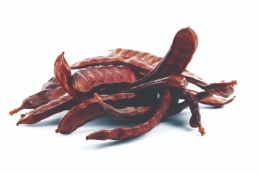Komiški Rogač Registered as EU Geographical Indication
 On March 22, 2023, the European Commission published its decision on entering the name ‘Komiški rogač’ (thick Komiža’s carob) in its register of geographical indications, meaning that this product name is now a protected GI throughout the European Union.
On March 22, 2023, the European Commission published its decision on entering the name ‘Komiški rogač’ (thick Komiža’s carob) in its register of geographical indications, meaning that this product name is now a protected GI throughout the European Union.
Croatia now has 42 agricultural and food products whose names are registered in the European Union as protected geographical indications, making it the seventh EU member state with the highest number of protected GIs.
A carob (Ceratonia siliqua) is a flowering evergreen tree or shrub in the legume family, widely cultivated for its edible fruit pods. The carob tree is native to the Mediterranean region and the Middle East.
‘Komiški rogač’ is a technologically mature fruit of the autochthonous so-called ‘thick Komiža carob’ variety from the town of Komiža area on the Croatian island of Vis, which is registered in the Croatian Plant Gene Bank. It is recognizable by its characteristic dark brown fruit or pods, which when ripe reach a length of 10 to 20 cm and a weight of 17 to 40 g, as well as a specific sweet taste and smell reminiscent of chocolate and cocoa.
Carob orchards with trees dating back hundreds of years can be found in Vis. ‘Thick Komiža carob’ trees are characterized by a lush and wide crown bringing forth abundant fruit with regular frequency. The fruit of this native variety is of exceptional quality, large and fleshy. Hundreds of years of farming knowledge applied by Komiža’s population resulted in this high-quality variety.
The carob tree originates in the Persian Gulf, from where it spread towards Anatolia and the regions of Lebanon, Palestine, Israel and Egypt. As early as 2000 years BC, the carob tree culture was accepted by Phoenicians and spread through the shores of the Mediterranean. Carob tree found its way to Dalmatia via the Greek colonists who founded their city states on Dalmatian islands. In the 4th century BC, Greeks from Syracuse founded the town of Issa in the Bay of St. George (present-day town of Vis) on the island of Vis. The Greeks brought grapevine and carob tree to the island. During Venetian rule, the town of Komiža became the largest carob tree habitat in Dalmatia, and Venice even passed a set of laws in an attempt to stimulate the planting of new trees. One of the requirements for the marriage contract, for example, was the plantation of a certain number of new carob trees.
The process of protecting the name ‘Komiški rogač’ was initiated by the local Association of Carob Breeders. The EU protected geographical indication will be visible on the packaging of Komiža’s carob.
By: Anamarija Stančić Petrović
For more information, please contact Anamarija Stančić Petrović, PETOŠEVIĆ Brussels representative.
Read more news on Croatia or Geographical Indications. Get our latest IP news or browse IP News Eastern Europe Archives.
